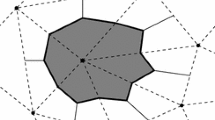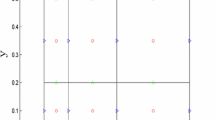Abstract
In this paper, a marker and cell (MAC) scheme is constructed for the free flow-porous media system with heat transport on non-uniform grids, where the Stokes-Darcy equation is employed to describe the free-flow and the porous regions. Error estimates for the velocity, pressure and temperature in different discrete norms are established rigorously and carefully by constructing discrete auxiliary functions. We obtain the second order superconvergence in the discrete \(L^2\) norm for velocity, pressure and temperature and the second order superconvergence for some terms of the \(H^1\) norm for the velocity on non-uniform grids. Several numerical examples verifying the theoretical results and illustrating the capabilities of the method are demonstrated.


Similar content being viewed by others
References
Arbogast, T., Wheeler, M.F., Yotov, I.: Mixed finite elements for elliptic problems with tensor coefficients as cell-centered finite differences. SIAM J. Numer. Anal. 34, 828–852 (1997)
Beavers, G.S., Joseph, D.D.: Boundary conditions at a naturally permeable wall. J. Fluid Mech. 30, 197–207 (1967)
Boubendir, Y., Tlupova, S.: Domain decomposition methods for solving Stokes-Darcy problems with boundary integrals. SIAM J. Sci. Comput. 35, B82–B106 (2013)
Brenner, S.C., Scott, L.R.: The Mathematical theory of finite element methods. 3rd edn (1994)
Camano, J., Gatica, G.N., Oyarzua, R., Ruizbaier, R., Venegas, P.: New fully-mixed finite element methods for the Stokes-Darcy coupling. Comput. Methods Appl. Mech. Eng. 295, 362–395 (2015)
Cao, Y., Gunzburger, M., Hu, X., Hua, F., Wang, X., Zhao, W.: Finite element approximations for Stokes-Darcy flow with Beavers-Joseph interface conditions. SIAM J. Numer. Anal. 47, 4239–4256 (2010)
Cao, Y., Gunzburger, M.D., He, X., Wang, X.: Parallel, non-iterative, multi-physics domain decomposition methods for time-dependent Stokes-Darcy systems. Math. Comput. 83, 1617–1644 (2014)
Cao, Y., Gunzburger, M.D., Hua, F., Wang, X.: Coupled Stokes-Darcy model with Beavers-Joseph interface boundary condition. Commun. Math. Sci. 8, 1–25 (2010)
Chen, H., Sun, S., Zhang, T.: Energy stability analysis of some fully discrete numerical schemes for incompressible Navier-Stokes equations on staggered grids. J. Sci. Comput. 75, 427–456 (2018)
Dawson, C., Wheeler, M.F., Woodward, C.S.: A two-grid finite difference scheme for nonlinear parabolic equations. SIAM J. Numer. Anal. 35, 435–452 (1998)
Girault, V., Lopez, H.: Finite-element error estimates for the MAC scheme. IMA J. Numer. Anal. 16, 347–379 (1996)
Han, H., Wu, X.: A new mixed finite element formulation and the MAC method for the stokes equations. SIAM J. Numer. Anal. 35, 560–571 (1998)
Hill, A.A., Straughan, B.: Poiseuille flow in a fluid overlying a porous medium. J. Fluid Mech. 603, 137–149 (2008)
Hill, A.A., Straughan, B.: Global stability for thermal convection in a fluid overlying a highly porous material. Proceed. R. Soc. A: Math., Phys. Eng. Sci. 465, 207–217 (2009)
Li, J., Sun, S.: The superconvergence phenomenon and proof of the MAC scheme for the stokes equations on non-uniform rectangular meshes. J. Sci. Comput. 65, 341–362 (2015)
Li, X., Rui, H.: Block-centered finite difference method for simulating compressible wormhole propagation. J. Sci. Comput. 74, 1115–1145 (2018)
Li, X., Rui, H.: Superconvergence of characteristics marker and cell scheme for the Navier-Stokes equations on nonuniform grids. SIAM J. Numer. Anal. 56, 1313–1337 (2018)
Li, X., Rui, H.: Superconvergence of a fully conservative finite difference method on non-uniform staggered grids for simulating wormhole propagation with the Darcy-Brinkman-Forchheimer framework. J. Fluid Mech. 872, 438–471 (2019)
Lipnikov, K., Vassilev, D., Yotov, I.: Discontinuous galerkin and mimetic finite difference methods for coupled Stokes-Darcy flows on polygonal and polyhedral grids. Numer. Math. 126, 321–360 (2014)
Mccurdy, M., Moore, N., Wang, X.: Convection in a coupled free flow-porous media system. SIAM J. Appl. Math. 79, 2313–2339 (2019)
Monk, P., Süli, E.: A convergence analysis of Yee’s scheme on nonuniform grids. SIAM J. Numer. Anal. 31, 393–412 (1994)
Nicolaides, R.: Analysis and convergence of the MAC scheme. I. the linear problem. SIAM J. on Numer. Anal. 29, 1579–1591 (1992)
Perot, B.: Conservation properties of unstructured staggered mesh schemes. J. Comput. Phys. 159, 58–89 (2000)
Perot, J.B.: Discrete conservation properties of unstructured mesh schemes. Annu. Rev. Fluid Mech. 43, 299–318 (2011)
Riviere, B., Yotov, I.: Locally conservative coupling of Stokes and Darcy flows. SIAM J. Numer. Anal. 42, 1959–1977 (2004)
Rui, H., Li, X.: Stability and superconvergence of MAC scheme for Stokes equations on nonuniform grids. SIAM J. Numer. Anal. 55, 1135–1158 (2017)
Rui, H., Pan, H.: A block-centered finite difference method for the Darcy-Forchheimer model. SIAM J. Numer. Anal. 50, 2612–2631 (2012)
Rui, H., Sun, Y.: A MAC scheme for coupled Stokes-Darcy equations on non-uniform grids. J. Sci. Comput. 82, 1–29 (2020)
Rui, H., Zhang, J.: A stabilized mixed finite element method for coupled Stokes and Darcy flows with transport. Comput. Methods Appl. Mech. Eng. 315, 169–189 (2017)
Rui, H., Zhang, R.: A unified stabilized mixed finite element method for coupling Stokes and Darcy flows. Comput. Methods Appl. Mech. Eng. 198, 2692–2699 (2009)
Saffman, P.G.: On the boundary condition at the surface of a porous medium. Stud. Appl. Math. 50, 93–101 (1971)
Shiue, M., Ong, K.C., Lai, M.: Convergence of the MAC scheme for the Stokes/Darcy coupling problem. J. Sci. Comput. 76, 1216–1251 (2018)
Wang, W., Xu, C.: Spectral methods based on new formulations for coupled Stokes and Darcy equations. J. Comput. Phys. 257, 126–142 (2014)
Acknowledgements
The authors would like to thank Prof. Xiao-Ping Wang from the Hong Kong University of Science and Technology for valuable discussions and suggestions.
Author information
Authors and Affiliations
Corresponding author
Additional information
Publisher's Note
Springer Nature remains neutral with regard to jurisdictional claims in published maps and institutional affiliations.
This work is supported by the National Natural Science Foundation of China under Grant Number 11901489, 12131014.
Appendix A Preliminaries for the Discrete LBB Condition
Appendix A Preliminaries for the Discrete LBB Condition
In this appendix, we give some details of the discrete LBB condition. Here we use notation and results similar to [26, 28]. Let
where \(\mathbf{V} = \mathbf{V} _f \cup \mathbf{V} _m\) with norm for the velocity
Here
with \(H(div;\Omega _m) \) as a Hilbert space defined by
Then we construct the finite-dimensional subspaces of W and \(\mathbf{V} \) by introducing three different partitions \({\mathcal {T}}_h,{\mathcal {T}}_h^1,{\mathcal {T}}_h^2\) of \(\Omega \). The original partition \(\delta _x\times \delta _y\) is denoted by \({\mathcal {T}}_h\) (see Fig. 3). The partition \({\mathcal {T}}_h^1\) is generated by connecting all the midpoints of the vertical sides of \(\Omega _{i+1/2,j+1/2}\) and extending the resulting mesh to the boundary \(\Gamma \). Similarly, for all \(\Omega _{i+1/2,j+1/2}\in {\mathcal {T}}_h\) we connect all the midpoints of the horizontal sides of \(\Omega _{i+1/2,j+1/2}\) and extend the resulting mesh to the boundary \(\Gamma \), then the third partition is obtained which is denoted by \({\mathcal {T}}_h^2\).
Corresponding to the quadrangulation \({\mathcal {T}}_h\), define \(W_h\), a subspace of W,
Furthermore, let \(\mathbf{V} _h\) be a subspace of \(\mathbf{V} \) such that \(\mathbf{V} _h= \mathbf{V} \cap ( \mathbf{V} _{f,h} \cup \mathbf{V} _{m,h}) \) equipped with the discrete norm for velocity
where
and \(Q_1\) denotes the space of all polynomials of degree \(\le 1\) with respect to each of the two variables x and y. On the porous medium \(\Omega _m\), define
and \(Q_{m,s}\) denotes the space of all polynomials of degree \(\le m\) with respect to x and degree \(\le s\) with respect to y. It is clear that \(\mathbf{V} _{m,h}\) is the lowest-order Raviart-Thomas-Nedelec (RTN) spaces on rectangles [1, 16].
Then we introduce the bilinear forms
where \( P_h: \ C^{(0)}(\overline{\Omega }_{i+1/2,j+1/2}) \rightarrow Q_0(\Omega _{i+1/2,j+1/2})\) such that
Rights and permissions
About this article
Cite this article
Li, X., Rui, H. Superconvergence of MAC Scheme for a Coupled Free Flow-Porous Media System with Heat Transport on Non-uniform Grids. J Sci Comput 90, 90 (2022). https://doi.org/10.1007/s10915-022-01763-5
Received:
Revised:
Accepted:
Published:
DOI: https://doi.org/10.1007/s10915-022-01763-5
Keywords
- MAC scheme
- Stokes-Darcy equation
- Heat transport
- Superconvergence
- Discrete auxiliary functions
- Non-uniform grids





